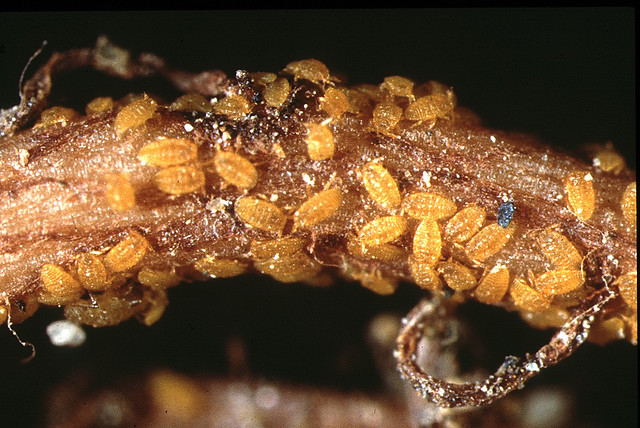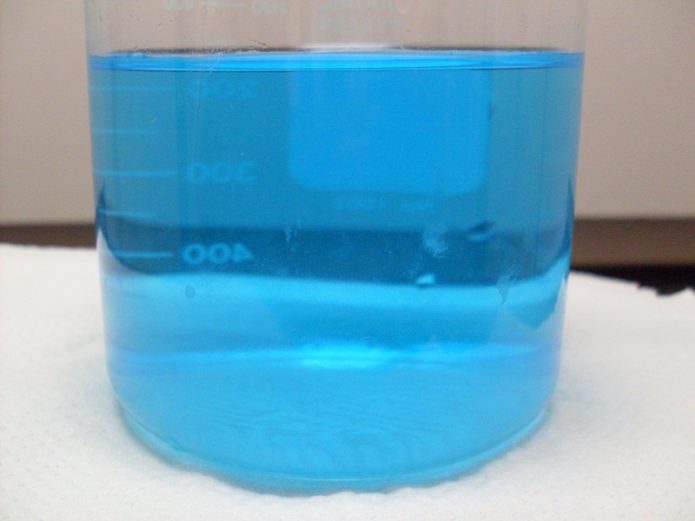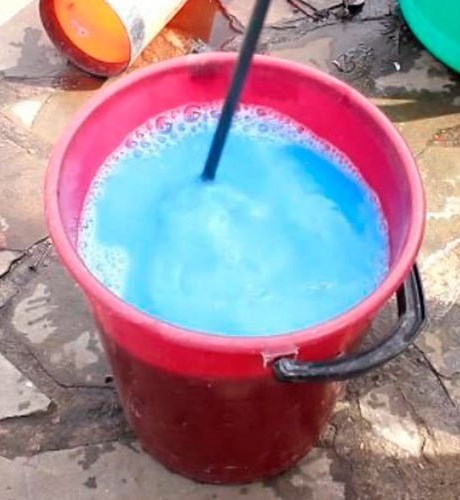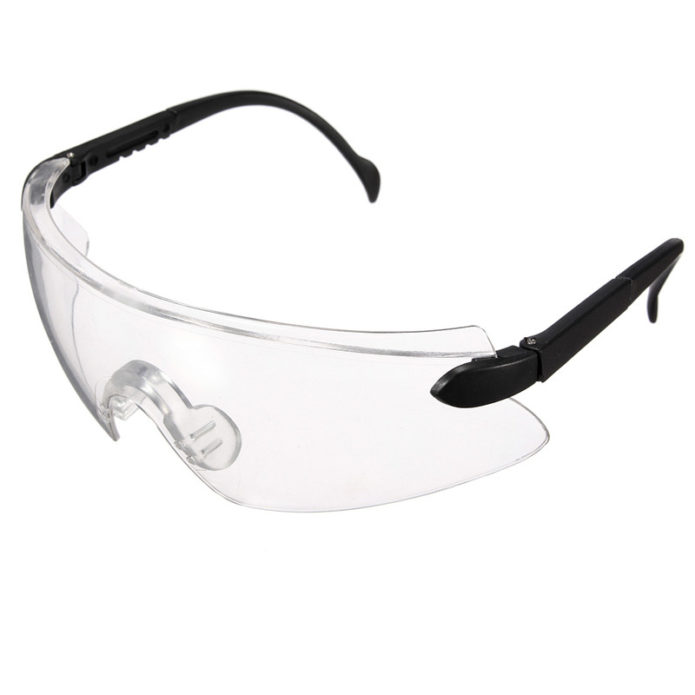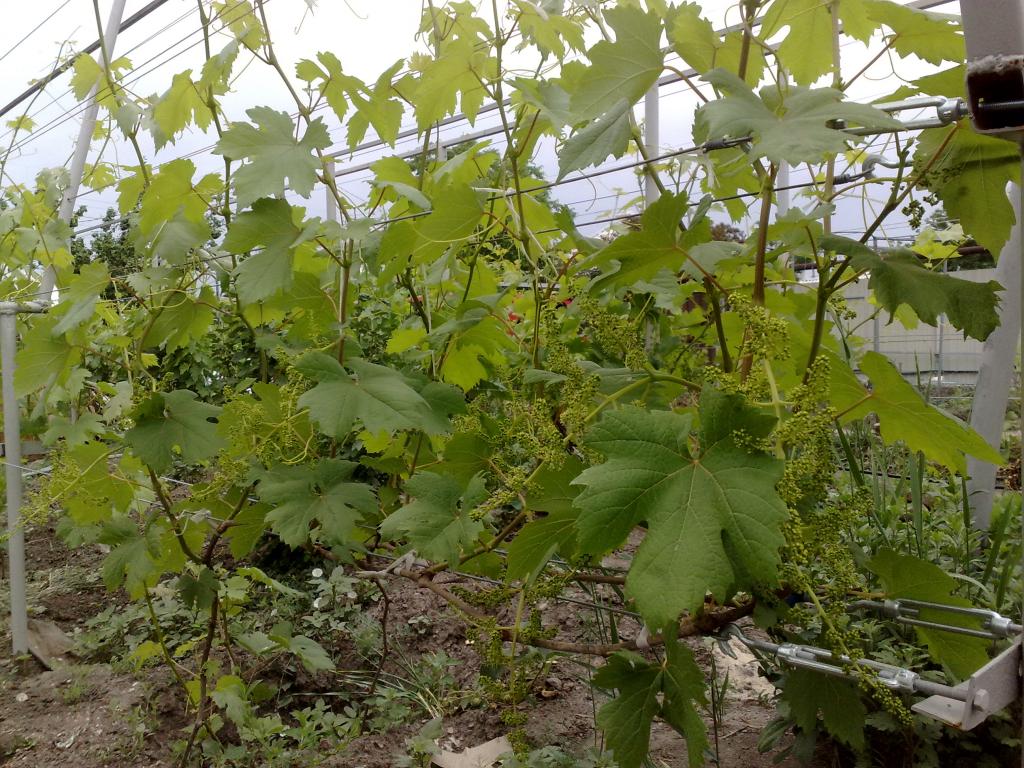Copper sulfate is a chemical preparation that has long been used in the practice of gardeners and gardeners. Due to its disinfecting and antiseptic properties, as well as its relatively low toxicity, it is widely used for the treatment of grape plants. Despite the emergence of a huge number of new drugs to combat diseases and pests, copper sulfate takes a firm place in the arsenal of summer residents and agricultural specialists.
Content
Characteristics of the drug
From the point of view of the structure of the molecule, copper sulfate is a crystalline hydrate. Its full chemical name is copper (II) sulfate pentahydrate. This shows that in a crystalline substance 5 water molecules are firmly bound to one copper sulfate molecule. When vitriol is dissolved in water, they are split off, and in an aqueous solution the drug is exactly the same salt as ordinary copper sulfate.
Anhydrous copper (II) sulfate salt is a white crystalline substance, odorless, easily absorbs water from the air. Copper sulfate is a much more stable compound. It easily crystallizes from blue-blue copper sulfate solutions in the form of beautiful blue crystals of CuSO45H2ABOUT.
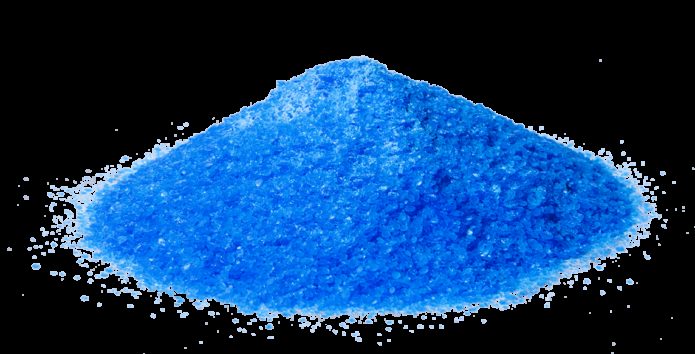
Crystals of copper sulfate are fascinatingly beautiful, which is often used in school classes when studying chemistry.
The chalcanite mineral with the same chemical formula is known in nature.
During storage, copper sulfate partially erodes, losing water and its wonderful appearance, therefore, the composition of the crystalline hydrate is not completely constant. Above 258 ° C, anhydrous salt forms.
It dissolves well in water, and with heating, the solubility increases sharply, and then decreases again. At room temperature, the solubility of the technical preparation is about 35.6 g per 100 ml of water. In an aqueous solution, it slowly hydrolyzes, as a result of which the solution has a rather acidic reaction (depending on the concentration, the pH can drop to 4 and below). Hydrolysis is prevented if necessary by adding a small amount of sulfuric acid.
In gardens and vegetable gardens, copper sulfate is most often used as part of a Bordeaux liquid (prepared from vitriol and lime), but quite often it is also used as an independent agent.
Copper is part of a number of plant enzymes. In this regard, in small doses, it is necessarily introduced into the soil as a microfertilizer.
But in much larger quantities, copper sulfate is used as a disinfectant and antiseptic. It has high fungicidal activity, protecting plants from pathogens of many diseases. However, unfortunately, it also exhibits phytoncidal properties, which limits its use during the growing season. It is better to use copper sulfate in the garden in early spring, against wintering forms of fungi.
Copper sulfate is a contact agent, that is, it acts locally, without penetrating into plant tissues.Excess drug is easily washed off by rain and water during watering.
It is used for both prophylactic and medicinal purposes, as well as for pre-planting disinfection of raspberries, currants, gooseberries and strawberry seedlings. Vitriol is active against moniliosis, scab, cytosporosis, various types of rot, spotting, etc. The toxicity to warm-blooded animals is relatively low, but it is a serious poison for fish.
In technical copper sulfate, iron is usually contained as an impurity, which in this situation does not in the least detract from the properties of the chemical: iron is also a microelement necessary for plant nutrition, and exhibits fungicidal properties. Treatment of grape bushes with copper sulfate and Bordeaux liquid prepared on its basis helps against fungal infections without causing significant harm to the crop.
In pure form, vitriol solution can be used in spring and autumn, and Bordeaux mixture, if necessary, in summer.
Copper sulfate is a relatively inexpensive, but quite effective drug. Much more often it is used in the Bordeaux liquid, where it is in the form of copper hydroxosulfate with the composition CuSO43Cu (OH)2active against fungal diseases. Copper preparations also significantly help in the fight against the most dangerous pest of the vineyard - phylloxera.
When using the formulations under consideration, it should be remembered that copper in large quantities is toxic to the human body. The maximum permissible concentration of copper in fruits and vegetables is quite low: only a few milligrams per kilogram. At the same time, special studies have established that, if the processing rules are followed, the copper content in grape fruits is significantly lower than the MPC. True, an increased content of copper was found in the leaves, but even in them it decreases to safe concentrations in about two weeks.
Terms and conditions for the treatment with copper sulfate
With a pure solution of copper sulfate, grape bushes are treated twice a season: in early spring and late autumn. If necessary, summer treatments, that is, during the growing season of plants, should be carried out exclusively with Bordeaux liquid, but in no case with an individual (pure) solution of copper sulfate. The fact is that a solution of copper sulfate has significant acidity that can burn the green parts of plants. It is to combat this phenomenon that slaked lime is introduced into it in strictly defined quantities. Moreover, a large excess of lime in the preparation of Bordeaux liquid is also unacceptable: strongly alkaline solutions, when they get on vegetative plants, are no less dangerous.
Unfortunately, you can often stumble upon unqualified advice on the use of copper preparations, where they confuse not only copper sulfate with Bordeaux liquid, but do not even distinguish between copper and iron sulfates. And if in the second case the trouble is not great, then replacing Bordeaux liquid with just copper sulfate during the growing season, you can be left without grapes!
The first processing of the vineyard is carried out when the bushes are opened after hibernation. It is aimed at destroying pathogens of infectious diseases, insect pests, and disinfecting bushes. The second time, the bushes are sprayed with a solution of an individual preparation when they are closed for the winter. If during the summer close observation of plants was carried out and diseases were destroyed "in the bud", autumn treatment has rather a preventive value, aimed at strengthening the immunity of the grape bush. During the summer, if signs of fungal diseases are detected, Bordeaux liquid is used.
It is impossible to say in advance what months to carry out the processing: it depends on the climate of the region and the current weather.But usually the first spraying occurs at the end of March, when pests become more active, but their concentration in the soil and on the bushes is still too low to cause serious damage. Processing should be carried out at positive air temperatures and in calm weather, preferably in the morning or in the evening. If the bushes were covered with flammable consumables (spruce branches of coniferous trees, tree foliage, brushwood), it is better to burn them. But a shelter such as boards, slate, etc., simultaneously with the treatment of the bushes, should also be sprayed with the same solution.
Spraying with Bordeaux liquid on green bushes is carried out before the beginning of flowering, as well as after its end. Before performing the procedure, the grape bushes need to be thinned out: breaking off the extra green shoots is beneficial to the bushes and is much easier to transfer by them than pruning already formed vines. In addition, unnecessary consumption of chemical is also useless.
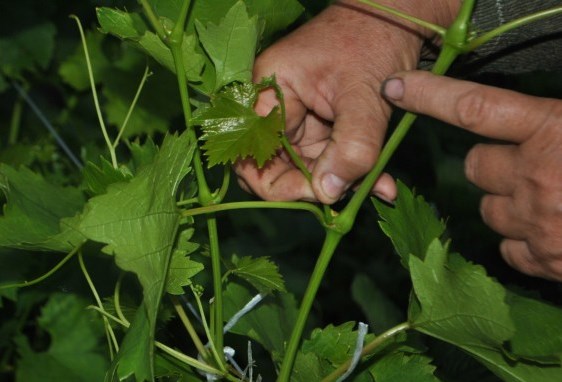
Before the summer spraying of the vineyard, it is worth breaking down the stepsons and extra green shoots.
In autumn, the grapes are sprayed after the foliage has completely fallen off. Autumn processing of vines is preventive in nature and prepares the bushes for the next season. But if the plants grew well in the summer, then the autumn processing is optional. Autumn processing is often combined with pruning and subsequent covering of the vine. After all, in the fall you have to remove a lot of wood: all areas of unripe vines, shoots thickening the bush, as well as clearly sick and broken ones. So why waste chemicals treating these areas if they will be immediately burned anyway?
Simultaneously with the processing of vines, irrigation of the soil should be carried out within a radius of up to a meter. Such disinfection will help destroy pathogens that live close to the surface.
Preparation and use of the drug
Copper sulfate dissolves easily in water, especially in warm water, and there are no difficulties in preparing its individual solutions. For processing grapes, large volumes are required, depending, of course, on the number and size of the bushes, but usually it is at least a few liters. Since the drug is relatively non-toxic to humans, the only degree of protection in the preparation of solutions is the use of rubber gloves. Experienced gardeners prepare solutions without gloves.
In no case should solutions of copper sulfate be prepared in metal dishes, especially iron and galvanized ones: a substitution reaction will begin immediately, both the solution and the bucket will deteriorate: there will be iron or zinc sulfate in the solution (yes, there are such ones!), And the walls of the dishes will be coated metallic copper. Therefore, plastic or glass vessels are needed. A plastic bucket is the best solution.
Copper sulfate solution
After measuring the required volume of clean water at room temperature or slightly warmed up and weighing the required amount of the drug, you just need to pour it into the water in a thin stream, stirring continuously. Usually, a 1% solution or a slightly more diluted solution is used, that is, the maximum weight of vitriol is 100 g per bucket of water. Then it should be mixed until completely dissolved and poured into a sprayer. If a small precipitate remains, the solution must be filtered or simply allowed to settle. The rate of the working solution is 1.5–2 liters per grape bush.
The prepared solution should not be mixed with other antifungal drugs: the result is unpredictable, since they belong to the most different classes of chemicals.
If the entire solution has not been used up, it can be sprayed with fruit bushes or fruit trees. The rest of the solution, if necessary, must be poured deep into the ground far outside the garden area, where nothing grows and planting is not expected.
The only useful additive to the copper sulfate solution during spring processing is urea.Urea (urea) is a highly concentrated and safe nitrogen fertilizer containing 46% nitrogen. It dissolves well in water. Granular urea does not cake during storage and disperses well. It is most suitable for summer foliar feeding with nitrogen by spraying with 0.5-1% aqueous solutions.
For spring processing of grape bushes, it is very convenient to use a combined solution, and in spring the concentration of urea is used much higher than in summer (up to 7%). A solution of a mixture of urea and copper sulfate for processing a vineyard is prepared as follows:
- 700 g of urea are poured into a 10-liter plastic bucket, 8 liters of water are poured and stirred until completely dissolved.
- In a glass jar, dissolve 50–100 g of copper sulfate in the required amount of warm water.
- The vitriol solution is poured in a thin stream into a bucket with a urea solution, water is added to a volume of 10 liters and mixed again.
Bordeaux liquid
The situation with the preparation of Bordeaux mixture is somewhat more complicated. The working solution is prepared as needed and used immediately, on the same day, its storage is excluded. Serious manufacturers produce Bordeaux mixture, not only by packing both of its components in separate packages in strictly necessary quantities, but also by attaching indicator paper to control the correct preparation of the solution. But if you got the components separately, you need to prepare the solution, strictly observing the proportions: after all, there will most likely not be an indicator of acidity in an ordinary family!
In a hopeless situation, an ordinary nail will help. If you hold it for a couple of minutes in the prepared liquid, you can evaluate the suitability of such a solution for spraying. A coating of copper on the nail indicates that it is necessary to add lime, that is, not all copper has yet been converted to hydroxosulfate, which means that the solution has increased acidity.
To prepare Bordeaux liquid, three non-metallic containers are needed: in the first one will need to dissolve copper sulfate, in the second - slaked lime, and in the third - to make a liquid ready for spraying by mixing both solutions. Depending on the situation, a 1% or 3% mixture can be used. A more concentrated solution is used in spring or autumn, and during the growing season - a diluted version.
A more concentrated version of the solution is prepared as follows.
In one vessel, it is necessary to dissolve 300 g of copper sulfate in 5 liters of water, and in another - 400 g of lime in 5 liters of water. We take into account that if in the first bucket we should get a beautiful transparent blue-blue solution, then in the second - a cloudy white liquid: lime dissolves poorly in water. The resulting milk of lime should be filtered through thick gauze or old tights. Then both liquids must be combined in one container, slowly pouring a solution of copper sulfate into the milk of lime with continuous stirring. You should get a light blue opaque liquid, which is a thin aqueous dispersion of copper hydroxosulfate. To prepare a diluted solution, you need three times less of each component for the same volume of water.
Video: preparing Bordeaux liquid
Safety measures when working with copper sulfate
Copper sulfate is a relatively toxic chemical. Precautions when using it must be strictly observed. They are important both in the preparation of the solution and in its application. Copper sulfate belongs to the substances of the 2nd hazard class in accordance with GOST 12.1.007. Class 2 - these are highly hazardous substances, which must be borne in mind when approaching work and copper sulfate with all responsibility.
This means that when working with the drug, you must take all measures to prevent its penetration into the body. External contact is relatively safe: when spilling the solution on the skin, there is absolutely no need to panic, but simply rinse the doused areas of the body with water. The situation is more complicated when the solution gets into the eyes: due to the hydrolysis of copper sulfate, its solutions are rather acidic, and rinsing the eyes with a stream of water should be carried out immediately. It is advisable to rinse them with a weak soda solution. If you do not have the skills to work with chemicals, it is better to wear glasses before preparing a solution of copper sulfate.
In case of accidental ingestion of copper sulfate, you need to drink 2–2.5 liters of warm water and be sure to induce vomiting. If large amounts of the solution are ingested, consult a doctor. To prevent this from happening, all chemicals should be stored separately from food and only special dishes should be used for preparing solutions.
Before spraying the vineyard, wear suitable clothing that covers as much of the skin as possible. Clothes should be washed as usual after work. It is advisable to use:
- any suit that completely covers the skin;
- shoes that can be easily washed;
- a headdress with the same characteristics;
- glasses that reliably protect eyes from splashing solution;
- a regular aerosol respirator (Alina, Petal, etc.) or at least a gauze bandage on the mouth and nose;
- rubber gloves.
Copper sulfate is a traditional simple remedy for combating plant diseases and pests. It is widely used by winegrowers due to its relatively low toxicity to plants and high efficiency. Spraying the vineyard with copper sulfate and Bordeaux liquid - a preparation based on it - reliably destroys most of the pathogens and increases the immunity of plants.
